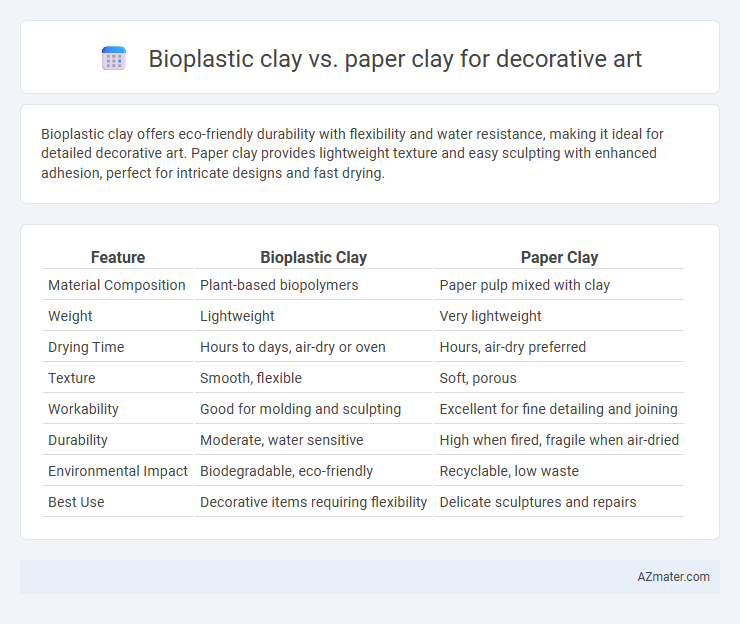Bioplastic clay offers eco-friendly durability with flexibility and water resistance, making it ideal for detailed decorative art. Paper clay provides lightweight texture and easy sculpting with enhanced adhesion, perfect for intricate designs and fast drying.
Table of Comparison
| Feature | Bioplastic Clay | Paper Clay |
|---|---|---|
| Material Composition | Plant-based biopolymers | Paper pulp mixed with clay |
| Weight | Lightweight | Very lightweight |
| Drying Time | Hours to days, air-dry or oven | Hours, air-dry preferred |
| Texture | Smooth, flexible | Soft, porous |
| Workability | Good for molding and sculpting | Excellent for fine detailing and joining |
| Durability | Moderate, water sensitive | High when fired, fragile when air-dried |
| Environmental Impact | Biodegradable, eco-friendly | Recyclable, low waste |
| Best Use | Decorative items requiring flexibility | Delicate sculptures and repairs |
Introduction to Bioplastic Clay and Paper Clay
Bioplastic clay is a sustainable, eco-friendly modeling material composed primarily of biodegradable polymers derived from natural resources such as starch and cellulose, widely used in decorative art for its smooth texture and easy moldability. Paper clay consists of clay mixed with cellulose fibers, enhancing its strength and flexibility while allowing artists to create lightweight, durable sculptures with fine detail. Both materials support environmentally conscious art practices but differ in composition, drying time, and finishing techniques, making them suitable for various decorative applications.
Material Composition: Bioplastic vs Paper Clay
Bioplastic clay is primarily made from biodegradable polymers derived from natural resources like cornstarch or cellulose, offering flexibility and water resistance ideal for decorative art. Paper clay incorporates cellulose fibers mixed with a ceramic or clay base, enhancing workability and reducing cracking during drying and firing. Both materials provide eco-friendly options, but bioplastic clay excels in moisture resilience, while paper clay delivers superior texture and lightweight properties.
Sustainability and Eco-friendliness
Bioplastic clay, derived from renewable plant-based materials, offers superior biodegradability and reduced environmental impact compared to synthetic clays, making it a sustainable choice for decorative art. Paper clay incorporates recycled cellulose fibers, enhancing its eco-friendliness by reducing waste and promoting reuse of paper products. Both materials support sustainable art practices, but bioplastic clay's compostable properties provide a more robust solution for minimizing landfill contributions.
Workability and Sculpting Properties
Bioplastic clay offers superior elasticity and moisture retention, making it highly pliable and ideal for detailed sculpting in decorative art. Paper clay features a lightweight, fibrous texture that enhances its strength when dry, allowing for delicate, intricate designs with less cracking risk. Both materials provide excellent workability but differ in drying times and finish textures, influencing the choice based on project requirements.
Drying Time and Durability
Bioplastic clay typically dries faster than paper clay, with drying times ranging from a few hours to a full day depending on thickness, making it ideal for quick projects. Paper clay is more durable and flexible once dry due to its cellulose fiber content, reducing the risk of cracking and increasing longevity in decorative art pieces. Artists often prefer paper clay for sculptures requiring intricate detail and strength, while bioplastic clay suits rapid prototyping and lightweight decorations.
Surface Finish and Texture Options
Bioplastic clay offers a smooth, uniform surface finish ideal for highly detailed decorative art, allowing precise sculpting and a glossy appearance after curing. Paper clay provides a textured, matte finish with a slightly porous surface, enabling artists to create natural, organic effects and easily blend layered textures. Both materials support versatile surface treatments, but paper clay excels in achieving rough, tactile textures while bioplastic clay favors sleek, polished results.
Painting and Decorating Compatibility
Bioplastic clay offers superior compatibility with acrylic and oil paints due to its smooth, non-porous surface that allows for vibrant color application and fine detailing in decorative art. Paper clay, composed of cellulose fibers, provides a more absorbent texture that enhances adhesion for water-based paints and mixed media, making it ideal for layered decoration and textured finishes. Both clays support diverse painting techniques, but bioplastic clay excels in durability and polish, while paper clay offers greater versatility in surface treatment and eco-friendliness.
Cost Comparison for Artists
Bioplastic clay generally costs more than paper clay due to its synthetic polymer content and durability, making it less accessible for budget-conscious artists. Paper clay, made from cellulose fibers and clay, offers an affordable alternative with ease of use and lightweight properties, appealing to artists focusing on cost efficiency. When evaluating cost-effectiveness, paper clay often provides better value for decorative art projects requiring volume without sacrificing quality.
Popular Applications in Decorative Art
Bioplastic clay is widely used in decorative art for creating detailed, durable sculptures and eco-friendly ornaments due to its non-toxic and biodegradable properties. Paper clay is favored for lightweight sculptures, intricate textures, and multi-layered art pieces because of its enhanced bonding ability and flexibility when dry. Popular applications in decorative art include model making, jewelry crafting, and mixed media projects where the choice between bioplastic and paper clay depends on the desired texture, strength, and environmental impact.
Choosing the Best Clay for Your Art Project
Bioplastic clay offers superior flexibility and water resistance, making it ideal for intricate decorative art projects requiring durability and smooth finishes. Paper clay is lightweight and easy to manipulate, perfect for sculptors seeking a softer texture and fast drying times, though it lacks the waterproof qualities of bioplastic. Artists should prioritize bioplastic for long-lasting, resilient decor and paper clay for delicate, easily carved designs with less emphasis on moisture resistance.

Infographic: Bioplastic clay vs Paper clay for Decorative Art
 azmater.com
azmater.com